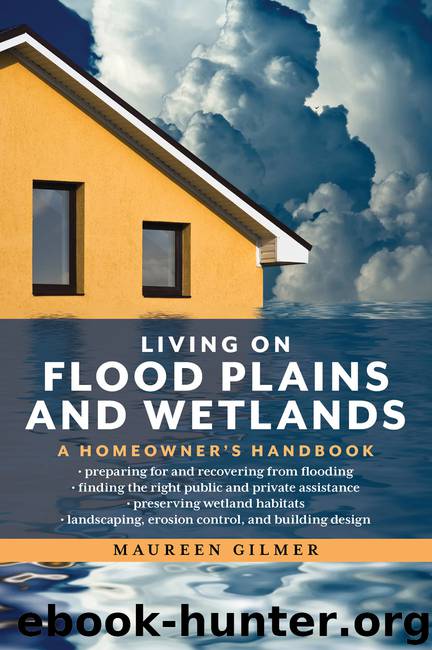Living on Flood Plains and Wetlands by Maureen Gilmer

Author:Maureen Gilmer
Language: eng
Format: epub
ISBN: 9781493038350
Publisher: Lyons Press
MECHANICAL EROSION CONTROLS
There are many different kinds of mechanical controls for immediate, if temporary, reduction of erosion on newly disturbed sites, such as newly burned watersheds, construction sites, large grading projects, and excavations. In many cases, these mechanical controls become permanent as part of the overall erosion control revegetation program. Refer to chapter 2 for more information on mechanical revetment and bank erosion control.
The goals of mechanical erosion control techniques:
1. To immediately protect exposed soil from the erosive splash of raindrops and reduce the subsequent runoff.
2. To slow the velocity of water flowing over the surface and thus reduce the potential for scouring.
3. To filter silt moving with the water and to cause it to settle out more quickly, preferably before it leaves the site.
4. To use absorbent materials, which hold a greater amount of runoff and help soils retain water that would otherwise become runoff.
5. To provide nooks and crannies suitable for germination of erosion control plant seed.
The following represent some of the most commonly used mechanical erosion control materials for immediate effect. Some, such as geo-textiles and gunite (concrete) treatments, are not listed because they are prohibitively expensive. However, for extreme conditions such as a home on the edge of a collapsing streambank, field professionals may feel one of these more costly methods are the only secure choice. Fortunately, the majority of means available are quite affordable.
PLASTIC SHEETING Sheets of plastic are a successful means of separating rainfall and runoff from the soil. They protect the surface against raindrop splash and, if properly anchored, divert runoff and keep the soil reasonably dry. But the plastic does not hold up long, tearing if battered by winds or debris. Sheeting is frequently used on levees with sandbags to reduce the amount of rainfall hitting the sloping outside surface. It is also helpful where wave action or oversaturation is threatening elevated-earth building pads, or where flash flooding has further undermined stream-banks that are eroding quickly and threatening homes. In most flood conditions, sandbags must be used to hold the plastic in place. Sheeting accomplishes erosion control goal 1 above.
Download
This site does not store any files on its server. We only index and link to content provided by other sites. Please contact the content providers to delete copyright contents if any and email us, we'll remove relevant links or contents immediately.
Audition by Ryu Murakami(4091)
The Body: A Guide for Occupants by Bill Bryson(3789)
Adulting by Kelly Williams Brown(3663)
Housekeeping by Marilynne Robinson(3396)
Zero Waste Home by Bea Johnson(3285)
Be in a Treehouse by Pete Nelson(3206)
Seriously... I'm Kidding by Ellen DeGeneres(3098)
Better Homes and Gardens New Cookbook by Better Homes & Gardens(2949)
Barkskins by Annie Proulx(2877)
The Healing Self by Deepak Chopra(2792)
Hedgerow by John Wright(2771)
The Life-Changing Magic Of Tidying Up- The Japanese Art Of Decluttering And Organizing (v5.0) by Marie Kondo(2742)
Spark Joy by Marie Kondo(2671)
The Genius of Japanese Carpentry by Azby Brown(2602)
The Cellar by Natasha Preston(2592)
Work Clean by Dan Charnas(2557)
120 Days of Sodom by Marquis de Sade(2428)
The Book of Numbers by Peter Bentley(2400)
A Monk's Guide to a Clean House and Mind by Shoukei Matsumoto(2400)
